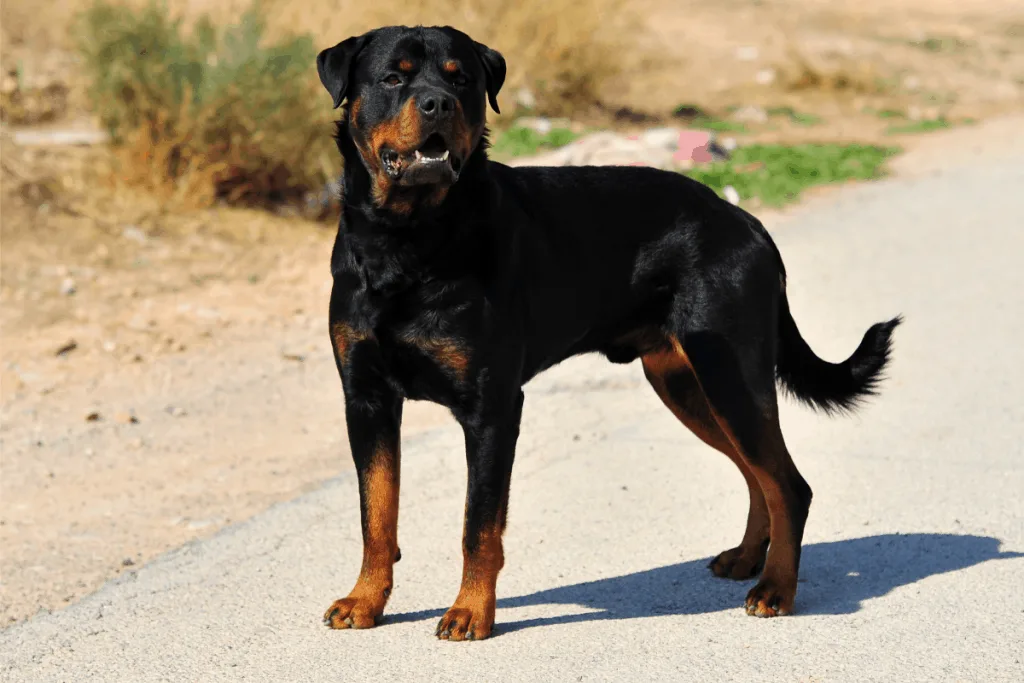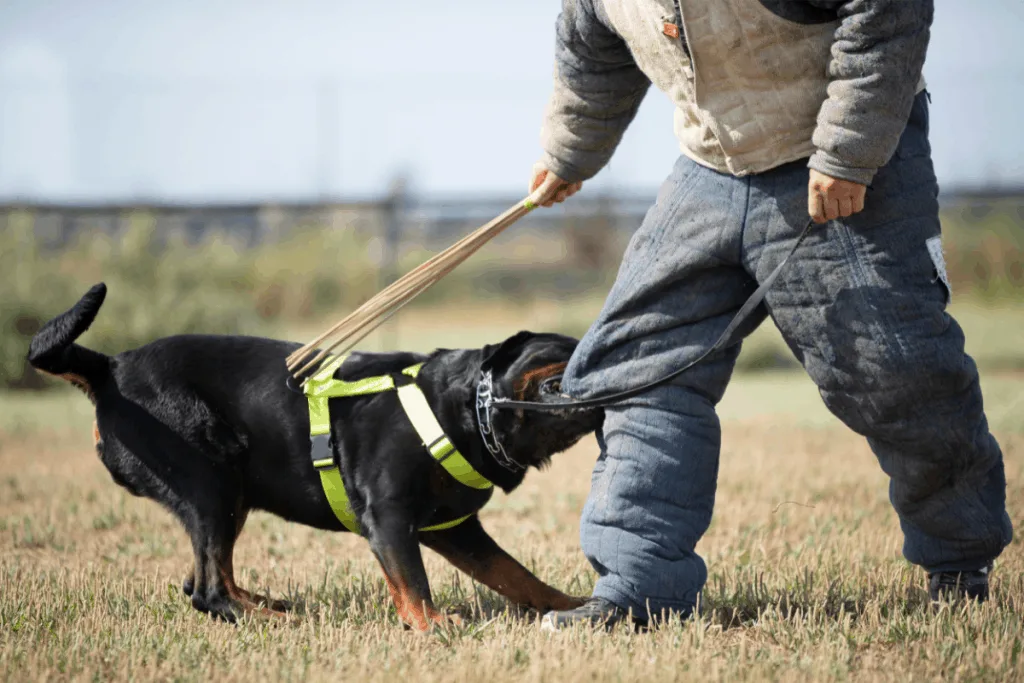Rottweilers are a famous German dog breed named after the town of Rottweil in the southwest of the country. But Rottweil was actually founded by the Romans.
So was it the Romans that used Rottweilers first?
Yes, the Romans used drover breed dogs such as the extinct Molossian. These are the assumed ancestors of the German Rottweilers. The exact history is not clear, but the Roman armies were heavily reliant on dogs to keep their living protein sources (livestock) from wandering away, getting lost, or stolen.
Rottweilers are natural herd dogs, and are one of the oldest breeds used to work with cattle.
Their personality and build also make also them suitable for pulling carts and delivering messages. These are all traits that were useful to ancient armies.

Click Here to Jump to a Section
What Were the Rottweilers Used for by the Romans?
Drover dogs, such as Molossian, are thought to be the ancestors of Rottweilers, were an essential component to the Roman army’s success.
“Droving” essentially means “driving stock” and is how cattle would get to market.
Thus, these dogs could keep a traveling food source, such as sheep and cows, from getting lost or stolen as the legions marched through territories.
While pillaging was a popular military tactic, and the Romans were not ethically against it, pillaging could not keep their legions alive. Nor were Roman supply trains sufficient for an enormous legions’ needs.
With refrigeration a long way off, the only way to provide fresh protein was to travel with it alive. Thus, drover dogs herded and guarded the cattle, the legions’ essential food.
As we touched on earlier, Drover dogs could also be used to deliver messages between posts and pull carts. A strong modern Rottweiler can pull up to 15,168 pounds (688 kg)!
A Rottweiler, or any dog moving this amount of weight sounds unreal, but take a look at the video below to see for yourself!
This versatility is essential to militaries such as the Romans. For example, they expected their soldiers to fight and have other skills such as blacksmith, butcher, or building and engineering.
Similarly, Rottweilers served various functions.
Where Did the Romans Get Molossian Dogs?
The now extinct Molossian is thought to come from the Molossian people, an ancient Greek mountain tribe, who could be found from northwest Ancient Greece to Southern Albania.
The breed was used to guard cattle and spread throughout the Balkans. The Molossians spread over to Rome as Romans colonized the Greeks.
Related: Are Rottweilers Good Farm Dogs?
The Rise of the Rottweiler in Germany
The history of the Romans’ dogs in Germany is not precise. However, we know the Romans occupied some of Germany, including conquering what is now Rottweil in 74AD.
The area was named Arae Flaviae. The area became a hugely popular trade center in Europe. The Romans (and their dogs) stayed until 260AD.
But not all the dogs descent from the Romans left with the retreat, as many had mixed into the local dog populations.
The area continued to be developed, and butchers in the area, much like the Romans, continued to use dogs to pull carts and herd and protect cattle.
They would also breed with local dogs, including the mastiff-like dogs of the neighboring Swiss Alps.
By 700 AD, in the area once known as Arae Flaviae, work began building a Christian church over what used to be Roman baths.
As the groundwork began, red tiles favored by Romans for their roofs were dug up. Thus, the site became known as “das Rote Wil” (the red tile), which led to the village name of Rottweil.
The area continued to be popular for trading, especially for cattle. People from France, Hungary, and Switzerland would drive their cattle to Rottweil.
The dogs would be everywhere, including guarding homes, butcher’s meat, and sometimes people would tie their money pouches to their dog’s neck.
Thus, traders began referring to these local dogs as Rottweiler Metzgerhund (Butcher’s Dog).
However, as railroads and trains began to spread in the mid-1800s, the need for dogs to help take cattle to market plummeted.
The rest of the cart work was done by horses or donkeys. Thus, the Rottweiler almost became extinct, although how close is unknown. However, it is claimed that the last female to keep the breed alive was found in Rottweil.
Rottweilers in Clubs, Police, and World War One
Despite a close call with extinction, the Rottweiler breed remains, and in Heilbronn 1882, a Rottweiler was shown for the first time.
In 1905, the Rottweiler was described as “a fine dog of unusual breed and irreproachable character” at an event organized by the Association of the Friends of Dogs.
In 1907, the DRK (“Deutscher Rottweiler-Klub” was established. Another club followed a couple of years later, eventually becoming the IRK (“International Rottweiler Club”).
Lord Von Der Tech, born 6 September 1914, became DRK’s main stud, with forty-eight descendants in three generations.
The club’s focus was breeding temperate, as required for the German Police force. Ralph Vom Neckar was the main stud for the IRK. They were trying to standardize the Rottweilers’ conformation and shape.
In 1921 the DRK and IRK merged into one club: Allgemeiner Deutcher Rottweiler Klub (ADRK). This is now the home club of the breed, recognized internationally. In 1924, ADRK released the first studbook.
While Rottweilers were popular with police, like their ancestors, the breed would also be part of the military.
World War I did not require dogs for herding cattle, but the Rottweilers would guard supplies and carry messages.
The Germans trained dogs to be able to sniff out the wounded and as spies. For the latter, dogs were trained to check out trenches and bark if there were people present.
Did All of Europe Have Dover Breed Dogs?
Ancient Roman legions did take dogs wherever they went. But people tend to breed dogs with what is available locally and promote traits that suit their needs, climate, and terrain.
Thus, the Roman military’s influence on dogs around Europe does extend past the Rottweiler. Again, as drover dogs are a mastiff-like breed, there is a high likelihood that they are progenitors to British breeds such as the English Mastiff and the Bulldog.
Are Rottweilers Still Used in Military and Police Work?

Rottweilers are still used in some militaries and police forces. What they do and how often they are used has evolved since the times of the ancient Romans, of course.
No longer does a food source need to be herded or do carts pulled.
Militaries like them because they are an intimidating breed to help coerce someone to cooperate or give up information.
Police outside of Germany have used them too, with London starting in 1889. France, Belgium, Australia, and the United States have also use Rottweilers in their work.
Rottweilers are not as commonly used as they once were, however.
The biggest reason for this is due to their size. Much work in both the police and militaries now requires their handler to be able to pick up and carry the dog. Rottweilers are a bulky breed and can be harder to lug around or have strapped to your chest.
The other issue is reputation as a “bully breed” and concerns of “overuse of force.”
For example, a Rottweiler’s bite force is 300 pounds (136 kg) per square inch, where a German Shepard’s is only 238 pounds (108 kg) per square inch.
Also, those that breed Rottweilers often don’t want the dogs to be doing police work because it adds to the breed’s bad reputation.
Part of the reason the police started using them is that they could do the jobs required but were so friendly and good with people. However, the attributes, such as their bite force, have made the public fearful, giving Rotties a bad name.
Thus, overall, Rottweiler fans prefer this breed not to be used in “aggressive” jobs. The more Rottweilers are seen being their sweet and friendly selves, the better for the breed’s reputation and overall longevity.
Final Thoughts
Rottweilers have served man for many years, despite almost becoming extinct.
While the breeds very survival hung in the balance, Rottweilers persevered, and are now one of the most recognizable dog breeds worldwide.
It is interesting to note, however, that their use as working dogs has declined, and they are now most prized for their fun and loving personalities.
